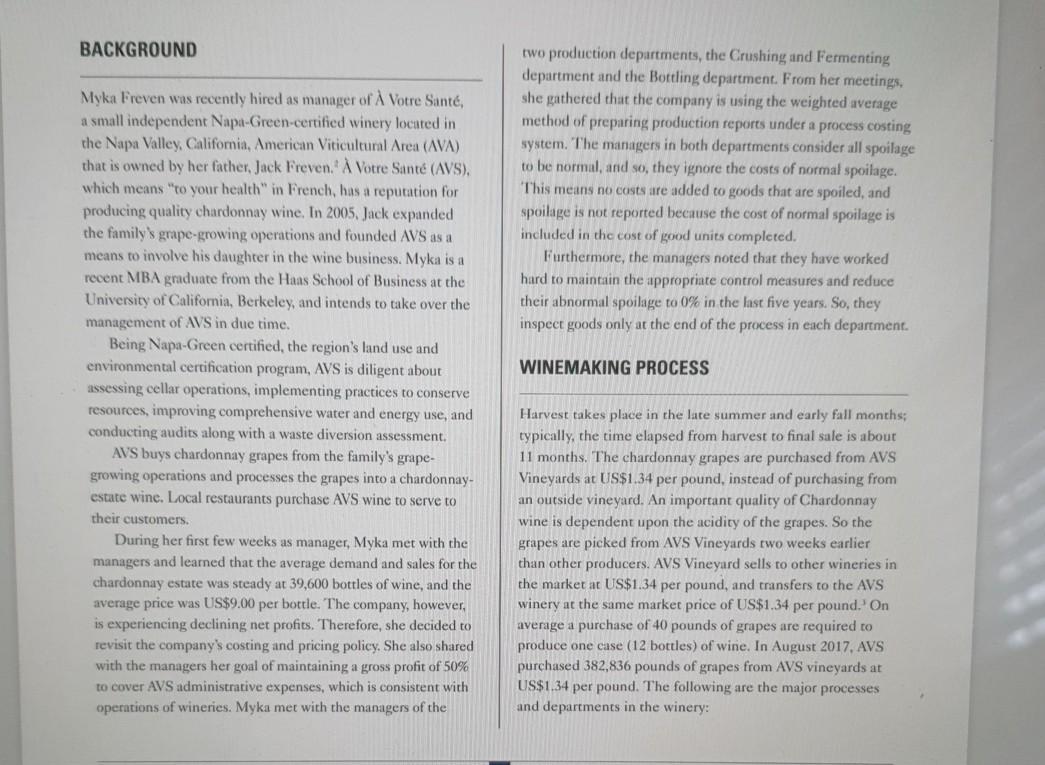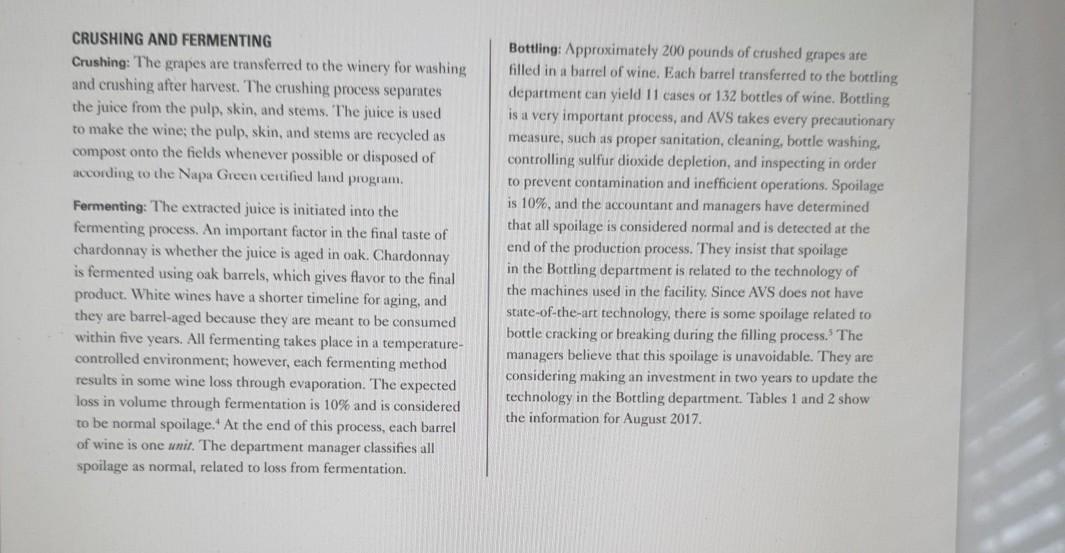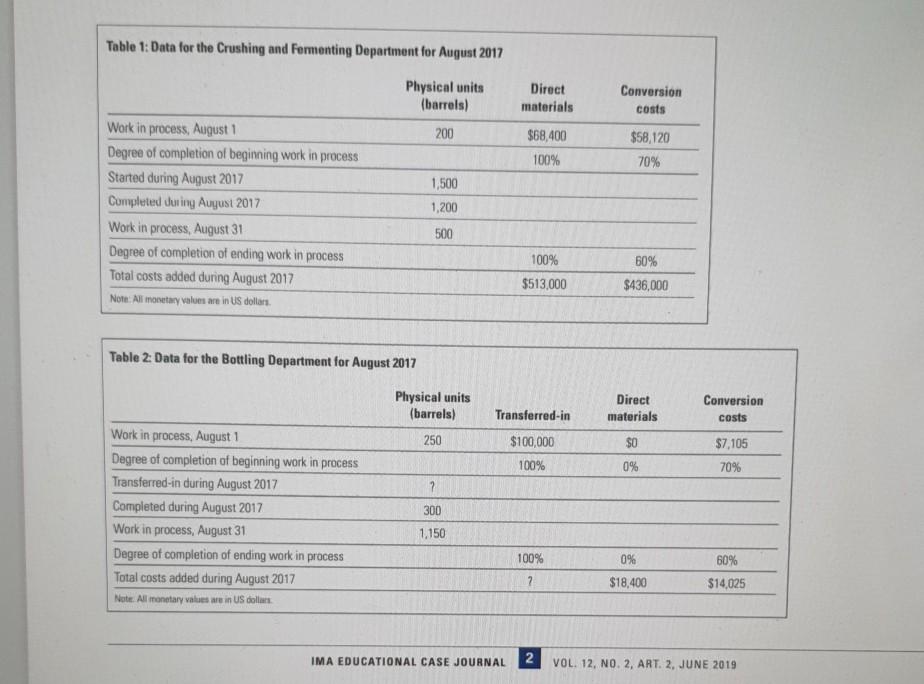Answered step by step
Verified Expert Solution
Question
1 Approved Answer
BACKGROUND two production departments, the Crushing and Fermenting department and the Bottling department. From her meetings, she gathered that the company is using the weighted




BACKGROUND two production departments, the Crushing and Fermenting department and the Bottling department. From her meetings, she gathered that the company is using the weighted average method of preparing production reports under a process costing system. The managers in both departments consider all spoilage to be normal, and so, they ignore the costs of normal spoilage. This means no costs are added to goods that are spoiled, and spoilage is not reported because the cost of normal spoilage is included in the cost of good units completed. Furthermore, the managers noted that they have worked hard to maintain the appropriate control measures and reduce their abnormal spoilage to 0% in the last five years. So, they inspect goods only at the end of the process in each department. WINEMAKING PROCESS Myka Freven was recently hired as manager of Votre Sant, a small independent Napa-Green-certified winery located in the Napa Valley, California, American Viticultural Area (AVA) that is owned by her father, Jack Freven. Votre Sant (AVS), which means "to your health in French, has a reputation for producing quality chardonnay wine. In 2005. Jack expanded the family's grape-growing operations and founded AVS as a means to involve his daughter in the wine business. Myka is a recent MBA graduate from the Haas School of Business at the University of California, Berkeley, and intends to take over the management of AVS in due time. Being Napa-Green certified, the region's land use and environmental certification program, AVS is diligent about assessing cellar operations, implementing practices to conserve resources, improving comprehensive water and energy use, and conducting audits along with a waste diversion assessment AVS buys chardonnay grapes from the family's grape- growing operations and processes the grapes into a chardonnay- estate wine. Local restaurants purchase AVS wine to serve to their customers During her first few weeks as manager, Myka met with the managers and learned that the average demand and sales for the chardonnay estate was steady at 39,600 bottles of wine, and the average price was US$9.00 per bottle. The company, however, is experiencing declining net profits. Therefore, she decided to revisit the company's costing and pricing policy. She also shared with the managers her goal of maintaining a gross profit of 50% to cover AVS administrative expenses, which is consistent with operations of wineries. Myka met with the managers of the Harvest takes place in the late summer and early fall months; typically, the time elapsed from harvest to final sale is abour 11 months. The chardonnay grapes are purchased from AVS Vineyards at US$1.34 per pound, instead of purchasing from an outside vineyard. An important quality of Chardonnay wine is dependent upon the acidity of the grapes. So the grapes are picked from AVS Vineyards two weeks earlier than other producers. AVS Vineyard sells to other wineries in the market at US$1.34 per pound, and transfers to the AVS winery at the same market price of US$1.34 per pound. On average a purchase of 40 pounds of grapes are required to produce one case (12 bottles) of wine. In August 2017, AVS purchased 382,836 pounds of grapes from AVS vineyards at US$1.34 per pound. The following are the major processes and departments in the winery: CRUSHING AND FERMENTING Crushing: The grapes are transferred to the winery for washing and crushing after harvest. The crushing process separates the juice from the pulp, skin, and stems. The juice is used to make the wine; the pulp, skin, and stems are recycled as compost onto the fields whenever possible or disposed of according to the Napa Green certified and program. Fermenting: The extracted juice is initiated into the fermenting process. An important factor in the final taste of chardonnay is whether the juice is aged in oak. Chardonnay is fermented using oak barrels, which gives flavor to the final product. White wines have a shorter timeline for aging, and they are barrel-aged because they are meant to be consumed within five years. All fermenting takes place in a temperature- controlled environment; however, each fermenting method results in some wine loss through evaporation. The expected loss in volume through fermentation is 10% and is considered to be normal spoilage. At the end of this process, each barrel of wine is one unit. The department manager classifies all spoilage as normal, related to loss from fermentation. Bottling: Approximately 200 pounds of crushed grapes are filled in a barrel of wine. Each barrel transferred to the bottling department can yield 11 cases or 132 bottles of wine. Bottling is a very important process, and AVS takes every precautionary measure, such as proper sanitation, cleaning, bottle washing. controlling sulfur dioxide depletion, and inspecting in order to prevent contamination and inefficient operations. Spoilage is 10%, and the accountant and managers have determined that all spoilage is considered normal and is detected at the end of the production process. They insist that spoilage in the Bottling department is related to the technology of the machines used in the facility. Since AVS does not have state-of-the-art technology, there is some spoilage related to bottle cracking or breaking during the filling process. The managers believe that this spoilage is unavoidable. They are considering making an investment in two years to update the technology in the Bottling department. Tables 1 and 2 show the information for August 2017 Table 1: Data for the Crushing and Fermenting Department for August 2017 Physical units (barrels) Direct materials Conversion costs 200 $68,400 100% $58,120 70% Work in process, Augusti Degree of completion of beginning work in process Started during August 2017 Completed during August 2017 Work in process, August 31 Degree of completion of ending work in process Total costs added during August 2017 Note: All monetary values are in US dollars. 1,500 1,200 500 100% 60% $436,000 $513.000 Table 2: Data for the Bottling Department for August 2017 Physical units (barrels) Transferred-in Direct materials Conversion costs 250 $7,105 $100,000 100% $0 0% 70% 7 300 Work in process, August 1 Degree of completion of beginning work in process Transferred-in during August 2017 Completed during August 2017 Work in process, August 31 Degree of completion of ending work in process Total costs added during August 2017 Note: All monetary values are in US dollar 1.150 100% 2 0% $18,400 60% $14,025 IMA EDUCATIONAL CASE JOURNAL 2 VOL. 12, NO. 2, ART. 2, JUNE 2019 3. Ethical Implications: What are the possible reasons for managers to state that all spoilage is normal? What additional information would you request from managers to confirm that there is no abnormal spoilage and that all spoilage is normal? ENDNOTES BACKGROUND two production departments, the Crushing and Fermenting department and the Bottling department. From her meetings, she gathered that the company is using the weighted average method of preparing production reports under a process costing system. The managers in both departments consider all spoilage to be normal, and so, they ignore the costs of normal spoilage. This means no costs are added to goods that are spoiled, and spoilage is not reported because the cost of normal spoilage is included in the cost of good units completed. Furthermore, the managers noted that they have worked hard to maintain the appropriate control measures and reduce their abnormal spoilage to 0% in the last five years. So, they inspect goods only at the end of the process in each department. WINEMAKING PROCESS Myka Freven was recently hired as manager of Votre Sant, a small independent Napa-Green-certified winery located in the Napa Valley, California, American Viticultural Area (AVA) that is owned by her father, Jack Freven. Votre Sant (AVS), which means "to your health in French, has a reputation for producing quality chardonnay wine. In 2005. Jack expanded the family's grape-growing operations and founded AVS as a means to involve his daughter in the wine business. Myka is a recent MBA graduate from the Haas School of Business at the University of California, Berkeley, and intends to take over the management of AVS in due time. Being Napa-Green certified, the region's land use and environmental certification program, AVS is diligent about assessing cellar operations, implementing practices to conserve resources, improving comprehensive water and energy use, and conducting audits along with a waste diversion assessment AVS buys chardonnay grapes from the family's grape- growing operations and processes the grapes into a chardonnay- estate wine. Local restaurants purchase AVS wine to serve to their customers During her first few weeks as manager, Myka met with the managers and learned that the average demand and sales for the chardonnay estate was steady at 39,600 bottles of wine, and the average price was US$9.00 per bottle. The company, however, is experiencing declining net profits. Therefore, she decided to revisit the company's costing and pricing policy. She also shared with the managers her goal of maintaining a gross profit of 50% to cover AVS administrative expenses, which is consistent with operations of wineries. Myka met with the managers of the Harvest takes place in the late summer and early fall months; typically, the time elapsed from harvest to final sale is abour 11 months. The chardonnay grapes are purchased from AVS Vineyards at US$1.34 per pound, instead of purchasing from an outside vineyard. An important quality of Chardonnay wine is dependent upon the acidity of the grapes. So the grapes are picked from AVS Vineyards two weeks earlier than other producers. AVS Vineyard sells to other wineries in the market at US$1.34 per pound, and transfers to the AVS winery at the same market price of US$1.34 per pound. On average a purchase of 40 pounds of grapes are required to produce one case (12 bottles) of wine. In August 2017, AVS purchased 382,836 pounds of grapes from AVS vineyards at US$1.34 per pound. The following are the major processes and departments in the winery: CRUSHING AND FERMENTING Crushing: The grapes are transferred to the winery for washing and crushing after harvest. The crushing process separates the juice from the pulp, skin, and stems. The juice is used to make the wine; the pulp, skin, and stems are recycled as compost onto the fields whenever possible or disposed of according to the Napa Green certified and program. Fermenting: The extracted juice is initiated into the fermenting process. An important factor in the final taste of chardonnay is whether the juice is aged in oak. Chardonnay is fermented using oak barrels, which gives flavor to the final product. White wines have a shorter timeline for aging, and they are barrel-aged because they are meant to be consumed within five years. All fermenting takes place in a temperature- controlled environment; however, each fermenting method results in some wine loss through evaporation. The expected loss in volume through fermentation is 10% and is considered to be normal spoilage. At the end of this process, each barrel of wine is one unit. The department manager classifies all spoilage as normal, related to loss from fermentation. Bottling: Approximately 200 pounds of crushed grapes are filled in a barrel of wine. Each barrel transferred to the bottling department can yield 11 cases or 132 bottles of wine. Bottling is a very important process, and AVS takes every precautionary measure, such as proper sanitation, cleaning, bottle washing. controlling sulfur dioxide depletion, and inspecting in order to prevent contamination and inefficient operations. Spoilage is 10%, and the accountant and managers have determined that all spoilage is considered normal and is detected at the end of the production process. They insist that spoilage in the Bottling department is related to the technology of the machines used in the facility. Since AVS does not have state-of-the-art technology, there is some spoilage related to bottle cracking or breaking during the filling process. The managers believe that this spoilage is unavoidable. They are considering making an investment in two years to update the technology in the Bottling department. Tables 1 and 2 show the information for August 2017 Table 1: Data for the Crushing and Fermenting Department for August 2017 Physical units (barrels) Direct materials Conversion costs 200 $68,400 100% $58,120 70% Work in process, Augusti Degree of completion of beginning work in process Started during August 2017 Completed during August 2017 Work in process, August 31 Degree of completion of ending work in process Total costs added during August 2017 Note: All monetary values are in US dollars. 1,500 1,200 500 100% 60% $436,000 $513.000 Table 2: Data for the Bottling Department for August 2017 Physical units (barrels) Transferred-in Direct materials Conversion costs 250 $7,105 $100,000 100% $0 0% 70% 7 300 Work in process, August 1 Degree of completion of beginning work in process Transferred-in during August 2017 Completed during August 2017 Work in process, August 31 Degree of completion of ending work in process Total costs added during August 2017 Note: All monetary values are in US dollar 1.150 100% 2 0% $18,400 60% $14,025 IMA EDUCATIONAL CASE JOURNAL 2 VOL. 12, NO. 2, ART. 2, JUNE 2019 3. Ethical Implications: What are the possible reasons for managers to state that all spoilage is normal? What additional information would you request from managers to confirm that there is no abnormal spoilage and that all spoilage is normal? ENDNOTES
Step by Step Solution
There are 3 Steps involved in it
Step: 1

Get Instant Access to Expert-Tailored Solutions
See step-by-step solutions with expert insights and AI powered tools for academic success
Step: 2

Step: 3

Ace Your Homework with AI
Get the answers you need in no time with our AI-driven, step-by-step assistance
Get Started


